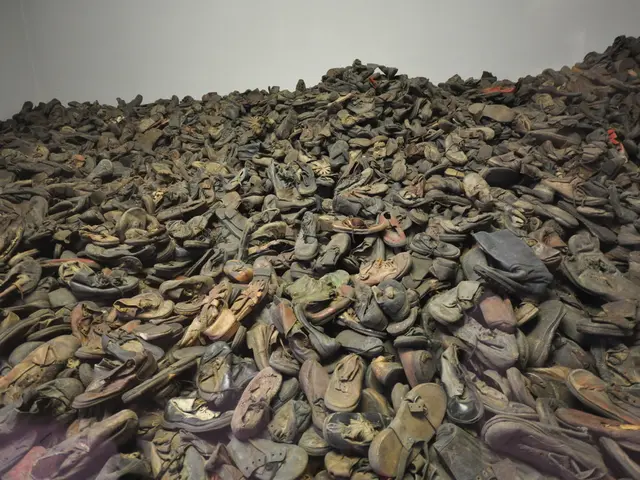Three Noteworthy Altcoins Backed by Tangible Assets to Monitor in May 2025
Crypto's Real-World Assets (RWA) are becoming the talk of the town as the sector evolves and faces increased scrutiny from institutions and regulators. The meltdown of MANTRA has served as a wake-up call, revealing hidden vulnerabilities in the RWA sector and driving calls for higher standards across tokenization platforms.
Although decentralized RWA projects have drawn skepticism, the case for asset-backed tokens strengthens - particularly with stablecoins and tokenized treasuries leading the charge in adoption. Amid this background, some RWA altcoins are gaining attention in May 2025, showcasing both technical momentum and renewed investor interest.
Stablecoins and Treasuries Fuel RWA Adoption
The collapse of Mantra has sparked introspection and caution throughout the RWA sector. As Andrei Grachev, Managing Partner of DWF Labs, puts it: "The Mantra collapse has exposed significant flaws in how these decentralized tokenization platforms operate. Investors are going to become much more discerning, demanding higher standards of due diligence. Regulators might also step up with additional scrutiny."
This event has shaken investor confidence in some decentralized RWA models, pushing them towards more regulated and validated alternatives.
The debate over RWA tokens' potential to detach from broader crypto market volatility is heating up. Followings Binance Research's observation that RWA tokens exhibit more stability than Bitcoin during tariff events, Edwin Mata, Co-founder & CEO of Brickken, said: "True RWA tokens are tied to real-world value and governed by legal frameworks that enforce rights, obligations, and cash flows. Over time, they behave more like traditional securities and can become more resilient to crypto market volatility, especially during turbulent periods."
Shahaf Bar Geffen, CEO and Founder of COTI, echoed this sentiment: "We're witnessing the early stages of a detachment from crypto market volatility. RWA tokens are tethered to tangible assets - real estate, commodities, invoices - providing an inherent stability layer missing in purely speculative cryptocurrencies. The potential for RWAs to hedge against macroeconomic volatility, such as tariffs or inflationary pressures, is significant."
The macroeconomic argument is gaining traction, but RWAs' technological and institutional support is advancing rapidly as well. Kadan Stadelmann, Chief Technology Officer at Komodo Platform, believes institutional adoption will be a decisive factor: "Mainstream financial institutions adopting RWAs will differentiate RWAs from the rest of the crypto market. No other crypto product will be as widely adopted by traditional finance as RWAs outside of stablecoins, which I argue are a type of RWA."
Thinning ranks of RWA coins to watch in May:
Ondo (ONDO)
With a nearly 14% climb over the last 30 days, Ondo has crossed the $1 mark again, and its market cap nears the $3 billion threshold. However, these price gains come amid a broader contraction in the RWA space, with total RWA on-chain value currently standing at $16.6 billion, a 16.92% decline over the same period.
Despite Ondo's recent surge, technical indicators indicate caution, with a death cross forming on its EMA lines - a pattern often linked to bearish momentum. Support levels lie at $0.866, $0.819, and $0.73, while resistance can be found at $1.04. A breakout above this threshold could set the stage for a rally toward $1.20.
Reserve Rights (RSR)
RSR has risen nearly 41% over the last 30 days since its Coinbase listing and remains linked to incoming SEC Chair Paul Atkins, who previously advised the project. Although Atkins no longer collaborates with the project, his past involvement has cultivated speculation about possible regulatory advantages.
If RSR can break the $0.0096 resistance level, it could propel gains toward $0.011 and $0.0137. Interestingly, failure to hold these levels could lead to a correction toward $0.0084, $0.0071, or even $0.0057.
TokenFi (TOKEN)
TokenFi (TOKEN), an RWA platform, has surged nearly 40% during the last seven days, pushing its market cap to $20 million. This uptrend comes despite a substantial drop in trading activity, with 24-hour volume slumping by over 59%.
From a technical standpoint, TokenFi is approaching key resistance levels. If bullish momentum prevails, TOKEN could challenge $0.024, $0.0275, and potentially $0.041. However, a reversal could push TOKEN down to $0.0194, $0.0137, or even $0.0112.
In the realm of RWA, tokenized gold dominates, combining stability with blockchain efficiency. Infrastructure projects like Avalanche, though not exclusively focused on RWAs, are often employed for RWA use cases. Emerging presale projects such as Kaanch Network and ChainFlux Protocol may expand RWA adoption, though specifics regarding their RWA integration remain unclear.
- The Mantra collapse has underscored the need for higher standards in the RWA sector, with players like DWF Labs advocating for enhanced due diligence.
- The stability exhibited by RWA tokens, such as stablecoins and tokenized treasuries, during tariff events has sparked debate about their potential for detachment from broader crypto market volatility.
- Edwin Mata, Co-founder & CEO of Brickken, believes that true RWA tokens, tied to real-world value, behave more like traditional securities and can provide resilience to crypto market volatility.
- Shahaf Bar Geffen, CEO and Founder of COTI, echoes this view, stating that RWA tokens tethered to tangible assets can hedge against macroeconomic volatility.
- Kadan Stadelmann, Chief Technology Officer at Komodo Platform, predicts that institutional adoption will distinguish RWAs from other crypto market products.
- Ondo (ONDO) has crossed the $1 mark again, but technical indicators show caution with a death cross on its EMA lines, suggesting potential bearish momentum.
- If Reserve Rights (RSR) can break the $0.0096 resistance level, it could propel gains towards $0.011 and $0.0137, although failure to hold these levels might lead to a correction.
- TokenFi (TOKEN) has surged nearly 40% during the last seven days, pushing its market cap to $20 million, despite a substantial drop in trading activity.
- Tokenized gold dominates the RWA sector, combining stability with blockchain efficiency, while infrastructure projects like Avalanche are often employed for RWA use cases.
- Emerging presale projects such as Kaanch Network and ChainFlux Protocol may expand RWA adoption, though details regarding their RWA integration remain unclear, with a focus on the RWA sector in 2025.






